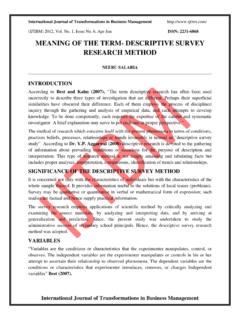Transcription of Youth With Disabilities in Juvenile Corrections: A ...
1 Exceptional Children Vol. 71, No. 3, pp. 339-345. 2005 Council for Exceptional Children. Youth with Disabilities in Juvenile Corrections: A National Survey MARY MAGEE QUINN. American Institutes for Research ROBERT B. RUTHERFORD. Arizona State University PETER E. LEONE. University of Maryland DAVID M. OSHER. JEFFREY M. POIRIER. American Institutes for Research ABSTRACT: Improving our knowledge of the number of incarcerated Youth with Disabilities can as- sist educators, other professionals, and policymakers to develop more effective services for Youth . This article reports the findings of a national survey conducted to determine the number of Youth identified as having Disabilities in the Juvenile corrections systems in the United States. The data show that, when compared to the national average, there is an overrepresentation of students iden- tified as having Disabilities , especially emotional disturbance, in those systems.
2 Ore than 134,000 Youth are Latino and many have significant learning or be- M incarcerated in public and private Juvenile correc- tional facilities in the United States (Sickmund, 2002). Many of these Youth enter Juvenile correc- tional facilities with intense educational, mental health, medical, and social needs. Large numbers havioral problems that entitle them to special ed- ucation and related services under the Individuals with Disabilities Education Act (IDEA). Profes- sionals have been aware of high rates of learning and behavioral disorders among incarcerated Youth for some time (Moffitt, 1990). The preva- lence of such disorders among the Juvenile justice of incarcerated juveniles are marginally literate or population (Otto, Greenstein, Johnson, & Fried- illiterate and have experienced school failure and man, 1992; Teplin, Abram, McClelland, Dulcan, retention (Center on Crime, Communities, and & Mericle, 2002), has led some professionals to Culture, 1997).
3 These Youth are also dispropor- characterize Juvenile justice as a default system . tionately male, poor, Black, Native American, or for Youth who can't read or write well, who have Exceptional Children 339. mental health problems, and who drop out or are suggests that delinquent youths' problem-solving forced out of school (Nelson, 2000). The extent strategies are less well developed than those of so- of this overrepresentation and the mechanisms as- cially competent adolescents. Thus, inadequate sociated with it are not well understood. The esti- social-cognitive development, common among mated prevalence of children and adolescents Youth with Disabilities , increases the risk of delin- with Disabilities in Juvenile corrections ranges quent and criminal behavior. from 30% to 70% (Casey & Keilitz, 1990; Mur- In a national survey, Rutherford and his col- phy, 1986; Rutherford, Nelson, & Wolford, leagues (1985) found a wide range among states on 1985).
4 However, most of the existing research in estimates of students with Disabilities in the juve- this area has been limited geographically and has nile and adult justice systems ( , 0% to 100%). been compromised by methodological problems These large differences appear to be associated with (Casey & Keilitz). several factors. There is great variability among and Several theories have emerged to explain within states in the ways in which education pro- the overrepresentation of Youth with Disabilities grams are funded and organized (Wolford, 2000). in correctional and detention facilities (Fink, This variability, along with the difficulties correc- 1990; Leone & Meisel, 1997). These include tional education programs have in obtaining prior school failure, susceptibility, differential treat- school records for students, contribute to variabil- ment, and metacognitive deficits.
5 The school fail- ity in the number of children served and, corre- ure theory (Osher, Woodruff, & Sims, 2002; Post, spondingly, the number reported to researchers 1981) asserts that learning, emotional/behavioral, conducting surveys. At the same time, the settle- and intellectual Disabilities lead either directly to ment of class action litigation in Juvenile correc- school failure or transactionally to school prob- tions in some states has most likely increased the lems and failure causing negative self-image, number of students identified and served in special which in turn leads to school dropout, suspen- education (Leone & Meisel, 1997). sion, and delinquency. The susceptibility theory holds that individuals with Disabilities have per- sonality and cognitive deficits that predispose THE PRESENT STUDY.
6 Them to criminal or delinquent behavior. These characteristics include (a) poorly developed im- In March 1997, the Office of Juvenile Justice and pulse control, (b) irritability, (c) suggestibility, (d) Delinquency Prevention, the Office of Special an inability to anticipate consequences, and (e) Education Programs, and several other agencies inadequate perception of social cues (Keilitz & and organizations convened an expert panel to ex- Dunivant, 1987). The differential treatment expla- amine the relationship between Disabilities and ju- nation asserts that although disabled and nondis- venile justice outcomes and to make abled delinquents engage in comparable recommendations (Coordinating Council on Juve- behaviors, the police, courts, and Juvenile correc- nile Justice and Delinquency Prevention, 1997).
7 Tions respond very differently to delinquent Youth The panel proposed a national survey to more with Disabilities (Keilitz & Dunivant). The definitively identify the number of students receiv- metacognitive deficits hypothesis (Larson, 1988) ing special education services in the Juvenile jus- tice system. Subsequently, the Center for Effective Collaboration and Practice and the National Cen- The prevalence of such disorders among ter on Education, Disability, and Juvenile Justice the Juvenile justice population, has led developed a survey of departments of Juvenile cor- some professionals to characterize Juvenile rections and local and state Juvenile detention agencies. The focus of that research, reported here, justice as a "default system" for Youth who was both to determine the percentage of students can't read or write well, who have mental identified as having Disabilities in the Juvenile jus- health problems, and who drop out or are tice system as well as to identify the percentage of forced out of school.
8 Students served by disability category. The original study surveyed both detention (short-term) and 340 Spring 2005. commitment (long-term) facilities. However, in order to avoid the potential of duplicate counts Several theories have emerged to explain from state agencies and detention centers, the sur- the overrepresentation of Youth with dis- vey results reported here include only data re- ported by state correctional systems. We do so abilities in correctional and detention because detention centers in several states are op- facilities. erated by state agencies, and there is a potential duplication of local and state counts. turn the survey and a cover sheet to return the survey via facsimile if they so chose. They were METHODS also given a toll-free number and an e-mail con- tact if they had any questions or concerns.
9 Re- P A R T I C I PA N T S minder postcards were mailed to all nonrespondents approximately 3 months after the Participants were the 51 heads of state depart- surveys were sent. Replacement surveys were then ments of Juvenile corrections or combined Juvenile mailed as requested. Reminder cards were mailed and adult corrections systems (or the equivalent again to nonrespondents 2 months later. Between departments or agencies). (At the time of this 6 and 8 months after the initial survey mailing, all study there were 42 heads of Juvenile systems and nonrespondents were contacted by telephone to 9 heads of combined Juvenile and adult correc- follow-up on the status of their surveys. All re- tions systems.) Thus, all state correctional systems spondents were assured that the information they and the District of Columbia were surveyed to in- provided was confidential and that data would be clude every Juvenile under age 22 incarcerated and used solely for analysis and reporting of aggre- committed to the Juvenile justice system.
10 Each gated information. agency surveyed was asked to use the data that were reported on their December 1, 2000, census D ATA A N A LY S I S. that was submitted to the Office of Special Educa- tion Programs at the United States Department of Descriptive analyses were conducted. Because of Education to complete the survey questions. This the wide variability in the size of facilities, medi- provided a nonoverlapping snapshot of the preva- ans and ranges are reported. lence rate of Youth with Disabilities in the Juvenile justice system on one given day. RESULTS. S U R V E Y D E V E LO P M E N T. R E S P O N S E R AT E S. The survey asked respondents to provide informa- tion about the number of Youth incarcerated in All combined Juvenile and adult correctional state and private facilities under contract with the agencies returned the survey (n = 9) and 29 of 42.






